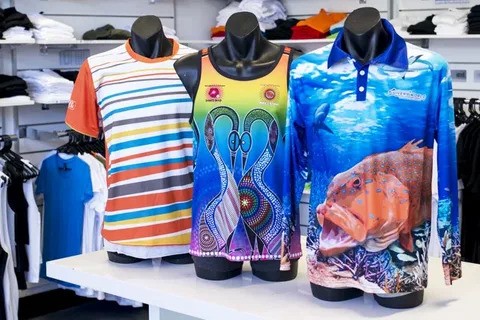Embroidery has long been a symbol of craftsmanship and elegance, transforming ordinary clothing into something unique and refined. When it comes to shirts, embroidery offers a timeless way to personalize, brand, or decorate garments with lasting appeal. Whether it’s a company logo on a uniform, a name on a work shirt, or a creative design for a fashion piece, embroidery on shirts adds quality, texture, and sophistication that printed designs often can’t match.
In today’s world of custom apparel, embroidery remains one of the most trusted and visually appealing decoration methods. Let’s explore why embroidered shirts continue to be a popular choice and how they bring together style, durability, and professionalism.
What Is Shirt Embroidery?
Embroidery on shirts involves stitching a design directly into the fabric using a computerized embroidery machine. These machines use digital files to guide the needle and thread, ensuring precision and consistency in every stitch. Unlike printing, which sits on top of the fabric, embroidery becomes part of the garment itself, giving it a three-dimensional, textured finish.
Designs can range from simple text or logos to intricate patterns and artwork. Businesses often choose embroidery for logos and branding, while individuals use it for personalization, fashion, or even gifts.
Why Choose Embroidery Over Printing?
When comparing embroidery to other decoration methods like screen printing or heat transfer, embroidery stands out for several reasons:
-
Professional Appearance – Embroidered shirts give a polished, high-end look that conveys quality and reliability. That’s why businesses often use them for uniforms, corporate events, and trade shows.
-
Durability – Embroidery doesn’t fade, peel, or crack over time. The design remains intact even after countless washes, making it ideal for long-term use.
-
Texture and Depth – The raised stitching creates a tactile feel and a luxurious finish that’s impossible to achieve with flat prints.
-
Versatility – Embroidery works well on a wide range of shirt types — from casual polos to dress shirts, jackets, and uniforms.
-
Color Retention – The high-quality thread used in embroidery retains its vibrancy and sheen over time, even when exposed to sunlight and frequent laundering.
For these reasons, embroidered shirts are often the preferred choice for professional settings and quality-conscious customers.
Types of Shirts That Work Best for Embroidery
Embroidery can be applied to almost any shirt material, but certain fabrics deliver the best results.
-
Polo Shirts: A classic choice for corporate or sportswear. The thicker fabric of polos supports embroidery beautifully.
-
Dress Shirts: Ideal for office environments, conferences, and formal events. Embroidered logos on the chest or cuff add a touch of elegance.
-
Work Shirts: Durable shirts used in industries like construction, maintenance, or hospitality often feature embroidered company logos and employee names.
-
Casual T-Shirts: With the right stabilizer and thread, even cotton tees can be embroidered for a stylish, personal look.
The key is to match the thread and design size to the fabric type for optimal quality and comfort.
Popular Uses for Shirt Embroidery
Embroidery serves various purposes, depending on who’s wearing it and why. Here are some of the most common applications:
-
Corporate Branding: Businesses use embroidered shirts to promote brand identity and professionalism. Employees wearing branded apparel look unified and trustworthy.
-
Team Uniforms: Sports teams and clubs use embroidered shirts to display logos, numbers, and names in a durable and stylish way.
-
Promotional Events: Custom-embroidered shirts make excellent giveaways that reflect quality and leave a lasting impression.
-
Personalized Gifts: Embroidered initials, names, or symbols make shirts thoughtful and personalized gifts for birthdays, weddings, and special occasions.
-
Fashion and Retail: Designers use embroidery to add decorative flair to shirts, combining art and fashion into wearable masterpieces.
The Embroidery Process
The embroidery process starts with digitizing — converting the design into a digital file that the embroidery machine can read. Once the design is prepared, the shirt is hooped to hold it tightly in place. The machine then uses colored threads to stitch the design precisely onto the fabric.
Modern embroidery machines can stitch thousands of stitches per minute with incredible accuracy. Depending on the design complexity, embroidery may take anywhere from a few minutes to over an hour per shirt. After stitching, the shirt is trimmed, inspected, and steamed to ensure a clean, professional look.
Caring for Embroidered Shirts
Proper care ensures that embroidery stays sharp and vibrant for years. Here are a few tips:
-
Wash embroidered shirts inside out in cold or warm water.
-
Avoid bleach or harsh detergents.
-
Air dry or tumble dry on low heat.
-
Iron on the reverse side if necessary to prevent damaging the threads.
With simple care, an embroidered shirt can maintain its elegance and structure long after printed designs fade away.
Conclusion
Embroidery on shirts is more than just decoration — it’s a statement of quality, style, and professionalism. From corporate uniforms to personal fashion, embroidered shirts communicate attention to detail and pride in presentation. They’re durable, versatile, and timeless, making them a worthwhile investment for any individual or business.
In a world full of printed garments, embroidered shirts stand out for their texture, depth, and classic appeal. Whether for branding, gifting, or fashion, embroidery brings a unique touch of sophistication that never goes out of style.

